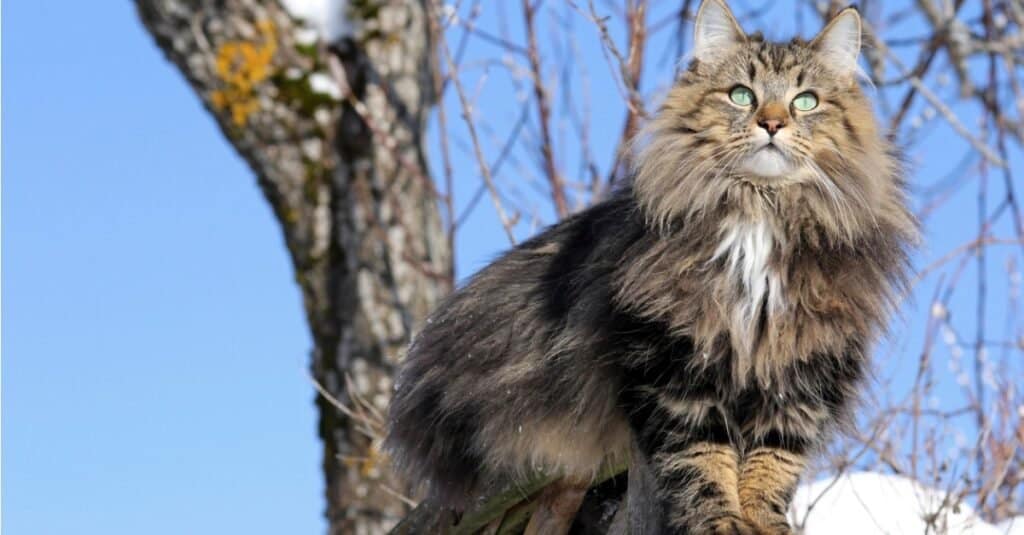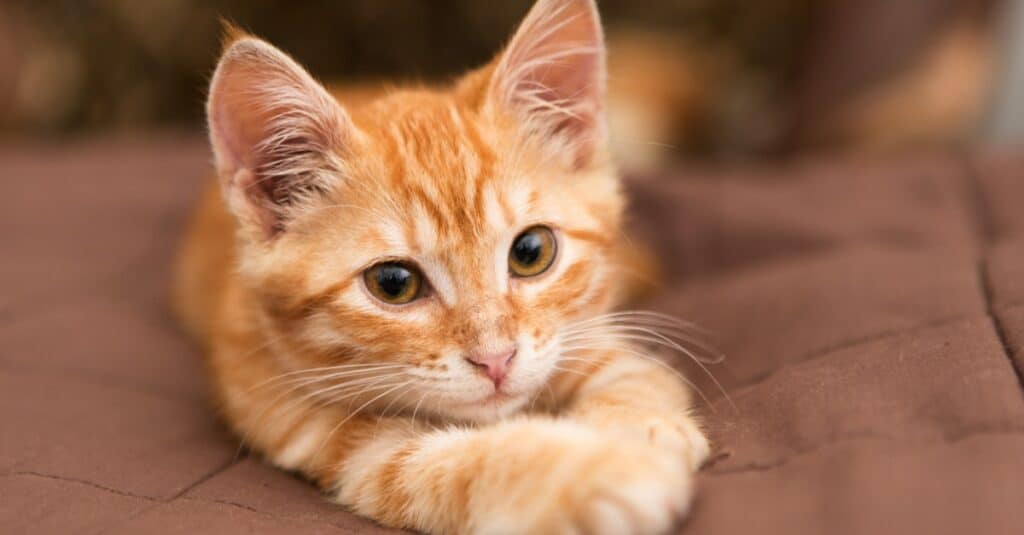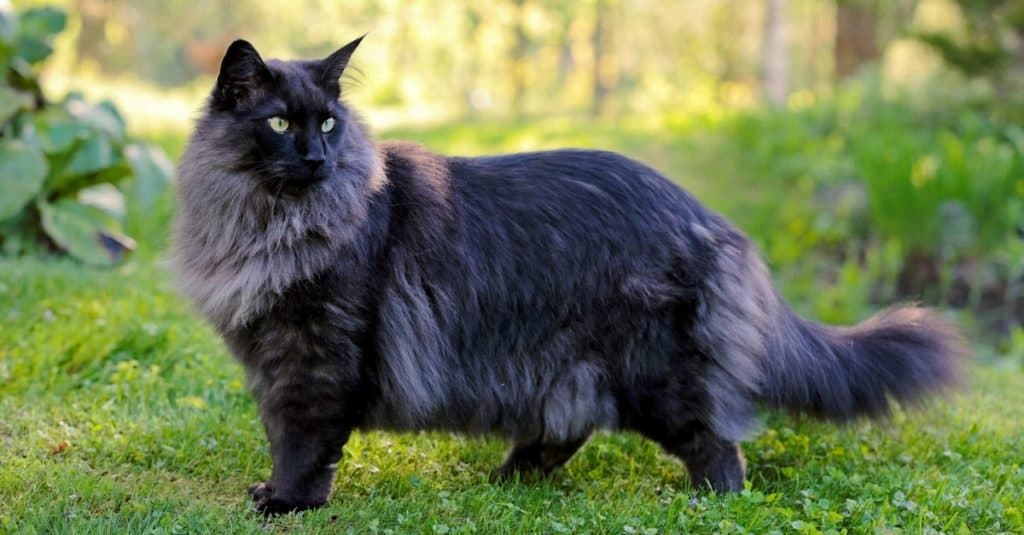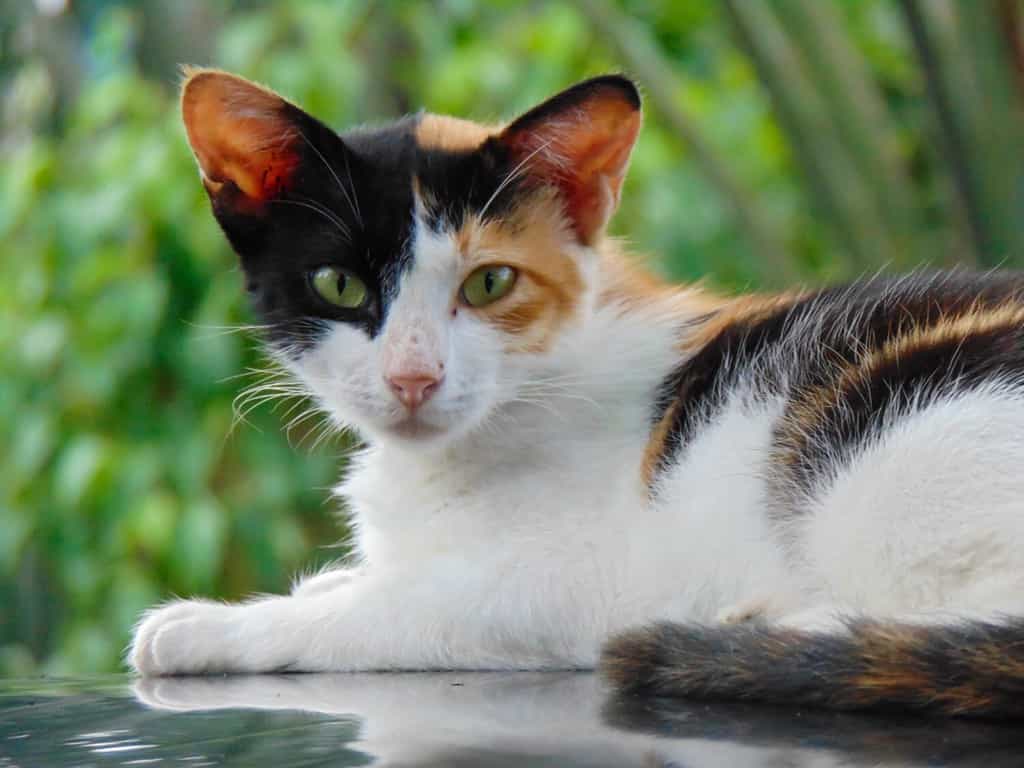The Norwegian forest cat is an ancient breed that has evolved naturally in Norway’s forests for centuries without human interference. So, they are considered an ancient breed. This cat goes by many names; for example, in some parts of the USA, their nickname is wegie, and its native name is skogkatt, which means “forest cat” in Norwegian. These large cats are notorious for their long, thick, silky coats and lynx-like ears with tufts. They are not the most affectionate cats, but they do form strong connections with their owners. But what most people love about them is their size. So, when it comes to comparing the Norwegian forest cat size vs. normal cat, just how big are they? Before this question can be answered, one must delve into the history of these two breeds, and how they evolved into the cats we know today.
Norwegian Forest Cat Vs. Normal Cat: History
Humans have used cats to help keep pests away and as pets for centuries, but these felines weren’t always domesticated. Both cat breeds had a very interesting transition from wild cats to human companions.
Norwegian Forest Cat

Some experts speculate that the modern-day Norwegian forest cat’s ancestors include the Turkish Angora and Siberian cat.
©iStock.com/Astrid860
The Norwegian forest cat is very important in Norse mythology as they are the Norse goddess, Freyja’s favorite animal. As a result, there are many drawings and artwork showing two Norwegian forest cats pulling her chariot. While these cats’ origins are unknown, cat fanciers think they traveled with the Vikings from England to Norway around 1000 A.D. Once there, they live in the forests for centuries, evolving into master hunters and climbers. However, some experts speculate that the modern-day Norwegian forest cat’s ancestors include the Turkish Angora and Siberian cat. After many years, these cats eventually traveled to farmlands, where they proved their worth as prized mouse hunters and eventually crept their way into the hearts of the natives.
Normal Cat

Domestic cats come in various colors and sizes. They can have short or long fur.
©iStock.com/Okssi68
Cats came into humans’ lives around 12,000 years ago when the earliest human settlements occurred in the Fertile Crescent (West Asia). As people evolved from their nomadic lifestyles and started developing farmlands, they were experiencing problems with rodents getting into their stored grain. The high population of rodents attracted Felix silvestris lybica or Middle Eastern wildcats. Soon most of these early towns were benefitting from the presence of these cats, and they became one of the most valued pets over time as new species of cat emerged, Felis catus, the domestic cat.
Norwegian Forest Cat Size Vs. Normal Cat
When it comes to Norwegian Forest cat size vs. normal cat, it’s obvious the latter is smaller. But by how much?
Norwegian Forest Cat
Norwegian forest cats are relatively large, weighing between 10 to 20 pounds. While quite large, they are very well-balanced, with a substantial bone structure and broad chest with considerable girth. Additionally, their front legs are shorter than their back legs, and their rump is somewhat higher than their shoulders. Furthermore, they have medium to large ears with a board bass and heavenly furred rounded tips. However, one of the breed’s most desirable characteristics is the tufts of hair on the end of their ears, referred to as lynx ears.
Their double coats keep them warm during the harsh Scandinavian winters. In addition, the layers of their double coats serve different purposes. For example, the outer coat is long, coarse, and water-resistant. However, the short, dense undercoat provides insulation. Norwegian forest cats come in several colors, shades, and patterns, including:
- Tabby
- Calico
- Bi-color
- Solid
- Tortoiseshell
- Smoke
- Cameo
The only colors not approved for purebreds are sable, lavender, chocolate, cinnamon, lilac, fawn, or Himalayan-type markings.
Normal Cat
The average weight for normal cats varies from 6 to 10 pounds. However, this breed is so diverse that some cats can weigh 28 pounds or more. In addition, males can measure 28 inches long, while females and grow to 20 inches long. Normal cats usually have long, slender bodies with long tails. But, many owners overfeed their cats, so many of them are overweight with round bellies.
Furthermore, domestic cats have small skulls and tiny teeth. These felines are agile and fast but are also usually great climbers and jumpers. As most owners know, normal cats have sharp claws. But, many people try to declaw their cats, which is cruel. Finally, they have fantastic vision and hearing, which makes them excellent hunters, and very aware of their surroundings.
Norwegian Forest Cat Vs. Normal Cat: Personality
The Norwegian forest cat and normal cat don’t just vary in size but also personality. Here are some of the traits you can expect from each breed:
Norwegian Forest Cat

Norwegian forest cats respond well to training and can be leash trained if they start at a young age.
©Elisa Putti/Shutterstock.com
The Norwegian forest cat is not the most affectionate cat, but they are easygoing and form strong bonds with their owners. In addition, they are a great choice for families with children because they are good with kids. Some of their best traits include patience, gentle nature, and curiosity. Furthermore, Norwegian forest cats respond well to training and can be leash trained if they start at a young age. Strangely, they are very similar to dogs and often play fetch with toys. As a result, they thrive in group settings with other dogs and cats. One tip when purchasing one of these massive cats is to buy a sturdy cat tree. This will hopefully keep them from scratching your furniture and provides them with the physical activity they need, especially if they are indoor cats.
Normal Cat

Not all normal cats have the same personality; there is so much variety among this breed that it’s hard to pinpoint certain traits.
©Mawaddah F/Shutterstock.com
Because this breed is so diverse, it’s hard to generalize about personality traits. However, most are affectionate, playful, vocal, and docile. Additionally, they are great pets for seniors or children, making them laugh with their silly antics. Normal cats are considered working cats because of their past reputation as rodent hunters.
Normal Cat
Because this breed is so diverse, it’s hard to generalize about personality traits. However, most are affectionate, playful, vocal, and docile. Additionally, they make great pets for seniors or children, making them laugh with their silly antics. Normal cats are considered working cats because of their past reputation as rodent hunters.
Norwegian Forest Cat Vs. Normal Cat: Health Concerns
Unfortunately, both breeds of cats have some worrying health concerns. The best thing to do is get pet insurance for your feline to ensure you can always rush them to the vet if anything goes wrong.
Norwegian Forest Cat
While there is not much one can do to prevent hereditary diseases, it is always good to be prepared and know what signs or symptoms to keep an eye on. Unfortunately, Norwegian forest cats are susceptible to the following:
- Hip Dysplasia
- Hypertrophic cardiomyopathy
- Pyruvate kinase deficiency
- Glycogen storage disease type IV (GSD IV)
- Polycystic kidney disease
- Retinal dysplasia
Normal Cat
Generally, normal cats are exposed to processed foods, disease-ridden rodents, and other factors that can influence their health. Unfortunately, these cats are susceptible to the following:
- Cancer – normal cats can get several types of cancer, which can be generalized (spread throughout their bodies) or localized (contained to one area like a tumor).
- FIV – Feline Immunodeficiency Virus may take years after the initial infection to show symptoms, severely weakening the immune system.
- Diabetes – Caused by lack of response to insulin or hormone insulin, which increases blood sugar levels.
- Rabies – Viral disease that affects the spinal cord and brain and results in death if untreated.
- Worms – Intestinal parasites that cause several symptoms, but if left untreated, can cause serious health issues.
The photo featured at the top of this post is ©
Thank you for reading! Have some feedback for us? Contact the AZ Animals editorial team.






